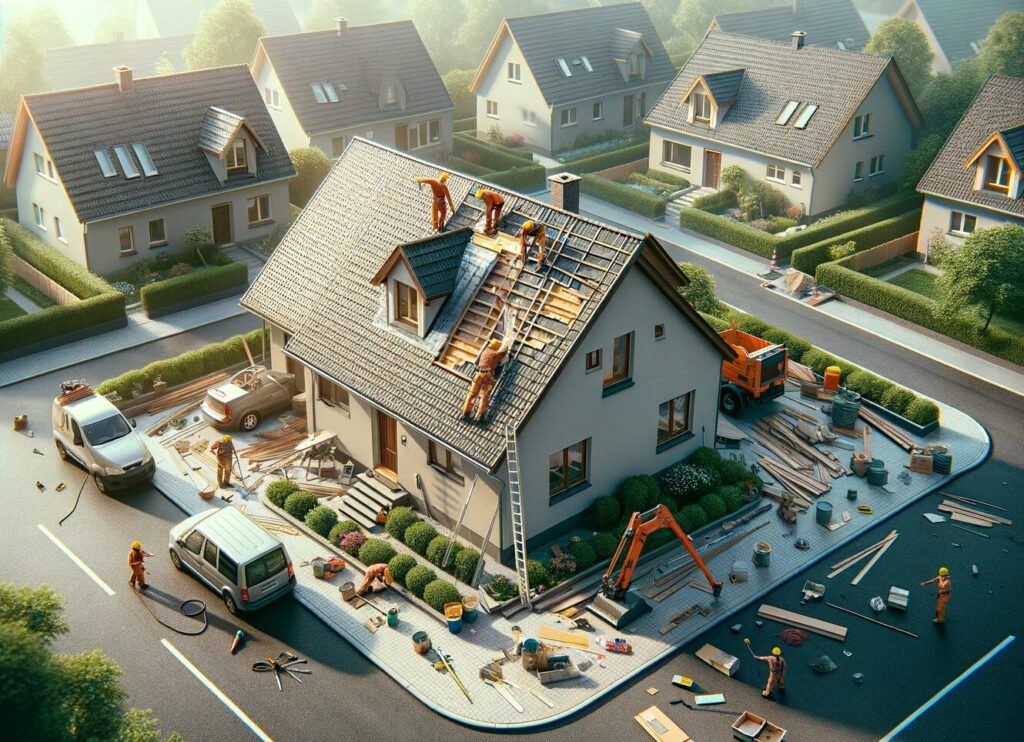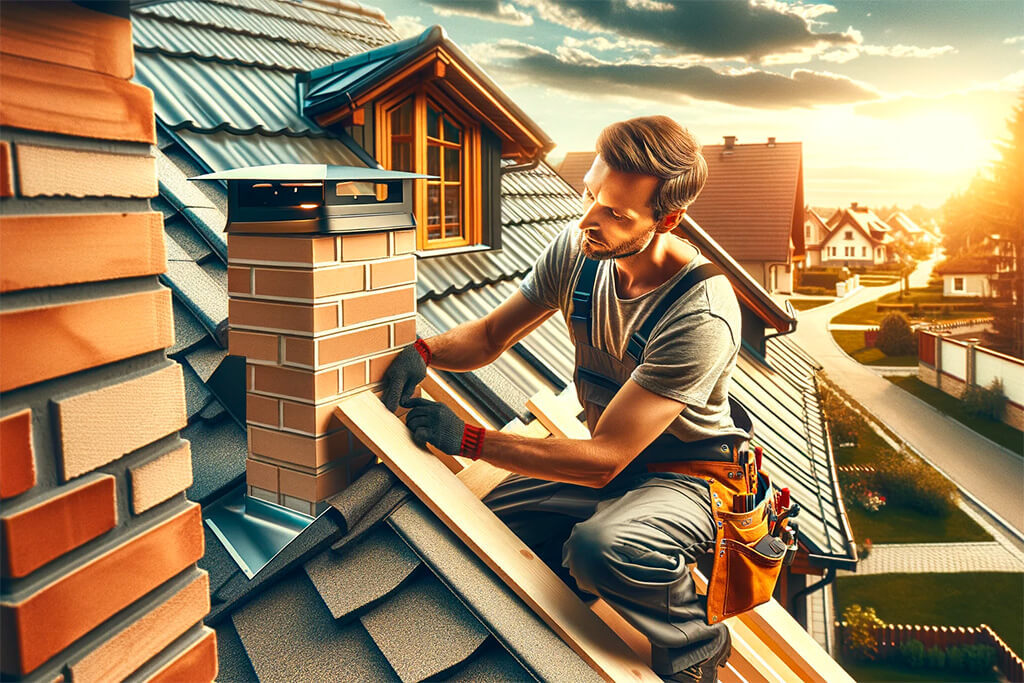The essence of maintaining and repairing roof shingles transcends mere home improvement—it’s about safeguarding the sanctity of your abode. These small, overlapping pieces of material form a barrier against rain, hail, and blistering sun. A well-kept roof is not just a barrier against the elements, it’s a bulwark that stands between comfort and calamity, ensuring your home remains dry, energy-efficient, and aesthetically pleasing. The contrast between a diligently maintained roof and one left to the whims of nature is stark, often manifesting in preventable leaks, energy inefficiencies, and a cascade of interior and structural issues. Recognizing the audience’s spectrum of experience, from seasoned professionals to burgeoning DIYers, I aim to demystify shingle repair. The goal is to equip you with the knowledge to preserve your roof’s integrity, regardless of your expertise level.

Understanding Roof Shingles
Roof shingles serve as the outermost sentinel of your home’s defense, tasked with repelling water, deflecting UV radiation, and resisting the assault of windswept debris. Beyond their protective role, shingles contribute significantly to your home’s visual appeal, offering an array of colors, textures, and patterns to complement its architectural ethos.
- Asphalt Shingles: The quintessential choice for their blend of affordability, durability, and ease of installation. Their ubiquity across American rooftops is a testament to their reliability and ease of repair.
- Wood Shingles: These bring a touch of natural beauty but demand vigilance against rot, mold, and termites to preserve their charm.
- Composite Shingles: Engineered from synthetic materials, they mimic the aesthetic virtues of wood or slate sans the intensive upkeep or investment.
- Metal Roofing: Though not traditional shingles, metal roofing merits mention for its durability, longevity, and growing popularity among homeowners seeking a modern roofing solution.
Identifying your roof’s shingle type is the first step toward tailored maintenance. Each material boasts its unique characteristics, lifespan, and signals when repair is due.
Signs Your Roof Shingles Need Repair
Learning to read the signs of shingle wear is akin to interpreting the nuanced language of your home’s exterior health. Here are the markers:
- Damaged Shingles: Look for cracks, splits, or missing pieces. On asphalt shingles, watch for granule loss, which exposes the base material to the elements.
- Missing Shingles: Wind and weather can dislodge shingles, leaving your roof’s underlayment vulnerable to the elements—a direct path to leaks.
- Curling or Buckling: These deformations signal aging or improper installation, compromising the shingle’s effectiveness.
- Algae Growth: Beyond an aesthetic nuisance, algae retains moisture, potentially inducing rot and undermining your roof’s integrity.
Tools and Materials Needed
Embarking on a journey of roof shingle repair, the essence lies in assembling an arsenal of tools and materials that are not just adequate but tailored for the task at hand. This selection process is not about extravagance but ensuring efficacy and precision in your work.
- Hammer: The cornerstone of any tool kit, indispensable for driving nails with precision and reliability.
- Pry Bar: A vital tool for carefully lifting damaged shingles and removing nails, a testament to the nuanced approach required in roof repair.
- Utility Knife: A sharp blade is crucial for cutting shingles accurately, reflecting the meticulous nature of the task.
- Roofing Nails: Opting for specific roofing nails underscores the importance of using materials designed for the purpose, ensuring longevity and stability.
- Replacement Shingles: Selecting shingles that closely match your existing ones is key, highlighting the attention to detail necessary for seamless repair.
- Roofing Cement: A symbol of the adhesion and resilience needed in roof repair, for sealing edges and patching holes effectively.
- Caulk Gun and Sealant: Essential for ensuring that vents and flashing are finished neatly, preventing future leaks.
- Ladder: The foundational access tool, its stability and safety are paramount.
- Safety Harness: An unequivocal necessity, it embodies the commitment to safety in every aspect of roof repair.
Safety gear, including gloves, goggles, and non-slip boots, is not just recommended but essential, emphasizing a holistic approach to safety in construction work.

Step-by-Step Guide to Repairing Roof Shingles
1. Safety First
Prioritizing safety transcends mere precaution, it is a fundamental aspect of construction work. Equip yourself with the necessary safety gear—a harness, helmet, gloves, and appropriate footwear. The unpredictable nature of weather also necessitates vigilance, always ensure conditions are safe for roofing work.
2. Inspection
The inspection phase is not merely about identifying obvious damage but involves a thorough and detailed examination of the roof. This step requires patience and a keen eye to spot signs of wear or damage, marking these areas clearly for subsequent repair.
3. Removing Damaged Shingles
The removal of damaged shingles is a delicate operation that demands a careful and measured approach. Using the pry bar, gently lift the affected shingles, being mindful not to damage the surrounding area. This step underscores the balance between strength and finesse inherent in construction work.
4. Preparing the Area
With the damaged shingles removed, the focus shifts to preparing the underlying area. This involves cleaning and assessing the underlayment for damage, reflecting the thorough and comprehensive nature of the repair process. It’s a testament to the adage that a strong foundation is key to lasting repairs.
5. Replacing Shingles
Installing new shingles is a task that combines technical skill with aesthetic judgment. Ensuring alignment and securing the shingles with roofing nails requires a methodical approach, emphasizing the importance of both form and function in construction work.
6. Sealing and Finishing Touches
The final steps involve sealing the edges of the new shingles with roofing cement and applying sealant around vents and flashing. This not only ensures the durability of the repair but also highlights the meticulous attention to detail that defines quality workmanship in the field of construction.
Advanced Tips for Shingle Repair
Navigating the nuances of shingle repair can sometimes feel like you’re charting through unmarked territory. Throughout my years, I’ve encountered a myriad of challenges, each with its own unique solution. Here’s how to tackle these with finesse:
- Matching New Shingles to Your Roof: Finding an exact match for your shingles can be daunting, especially if they’ve been weathered or if the product line has been discontinued. When an exact match is elusive, aim for the closest possible shade. Strategically placing new shingles in less conspicuous areas or interspersing them among the old can help blend the differences, creating a more uniform appearance without drawing attention to the repair.
- Addressing Common Challenges: Sometimes, you’ll find shingles that stubbornly refuse to conform to their intended position or fail to seal properly. A small amount of roofing cement under each troublesome corner can coax them into place. If sealant activation is the issue, a careful application of heat from a heat gun can soften the adhesive without damaging the shingle, encouraging it to stick.
Maintenance Tips to Prolong Shingle Life
The longevity of your roof is significantly influenced by the care it receives. It’s the distinction between preventative maintenance and a full-scale overhaul.
- Regular Inspection and Maintenance: I recommend a biannual inspection of your roof to catch potential issues early. This is particularly crucial following severe weather events, which can exacerbate or reveal vulnerabilities. Pay attention to signs of wear such as missing, damaged, or curling shingles, and address these problems promptly to mitigate further damage.
- Preventative Measures: Simple actions like keeping gutters clear and trimming nearby tree limbs can prevent damage and water buildup. Equally important is ensuring proper attic ventilation to avoid heat accumulation that can prematurely age your roof.
FAQ Section
A shingle that’s cracked, torn, or significantly missing material should be replaced. Minor damages, such as a small corner lift, can often be remedied with a bit of roofing cement.
Minor repairs are within the reach of a DIY enthusiast equipped with the right tools and safety measures. However, extensive damage or complex issues are best left to professionals, ensuring safety and quality.
A thorough inspection twice a year, as well as after any major storms, can help catch and address issues before they escalate.
Asphalt shingles typically offer 20 to 30 years of service, whereas materials like metal or slate can exceed 50 years with proper care.
Consistent maintenance, timely repairs, and ensuring your attic is well-ventilated are key strategies to maximize your roof’s lifespan.
Should you uncover damage beyond the scope of a simple repair, consulting with a professional roofing contractor is advisable. They can assess the extent of the damage and recommend the best course of action, whether it be a comprehensive repair or a full replacement.
